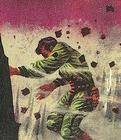 If you're a fan of pulp author Edgar Rice Burroughs and his fictional red planet Barsoom, here are some recent links worth checking out. The science fiction blog io9 posted a fascinating four-part series called Reading Barsoom by John Marr:
If you're a fan of pulp author Edgar Rice Burroughs and his fictional red planet Barsoom, here are some recent links worth checking out. The science fiction blog io9 posted a fascinating four-part series called Reading Barsoom by John Marr:1) How Edgar Rice Burroughs became one of the twentieth century's biggest scifi authors
2) A naked princess and slave rebellions in Edgar Rice Burroughs' first Martian trilogy
3) In Burroughs' second Barsoom series, the right girl winds up in the right body
4) In Burroughs' final Barsoom series, we see urban Mars, synthetic flesh, and Nazis of Jupiter
Also, the blog John Carter of Mars Reader updated its reviews of the Barsoom novels and posted a review of the once-indispensible and still hip A Guide to Barsoom (1976):
• A Princess of Mars (1917)
• The Gods of Mars (1918)
• Warlord of Mars (1919)
• Thuvia, Maid of Mars (1920)
• The Chessmen of Mars (1922)
• The Master Mind of Mars (1928)
• A Fighting Man of Mars (1931)
• Swords of Mars (1936)
• A Guide to Barsoom (1976) by John Flint Roy
Lastly, the Wednesday Journal of Oak Park and River Forest in Chicagoland reported on the recent annual gathering of the Burroughs Bibliophiles, which featured an appearance by the lovely Llana Jane Burroughs, great-granddaughter of Edgar Rice Burroughs!
.JPG)
.JPG)
.jpg)
.JPG)
.JPG)
.JPG)
.JPG)
.JPG)
.JPG)
.JPG)
.jpg)

.JPG)
.JPG)
.JPG)

.JPG)




